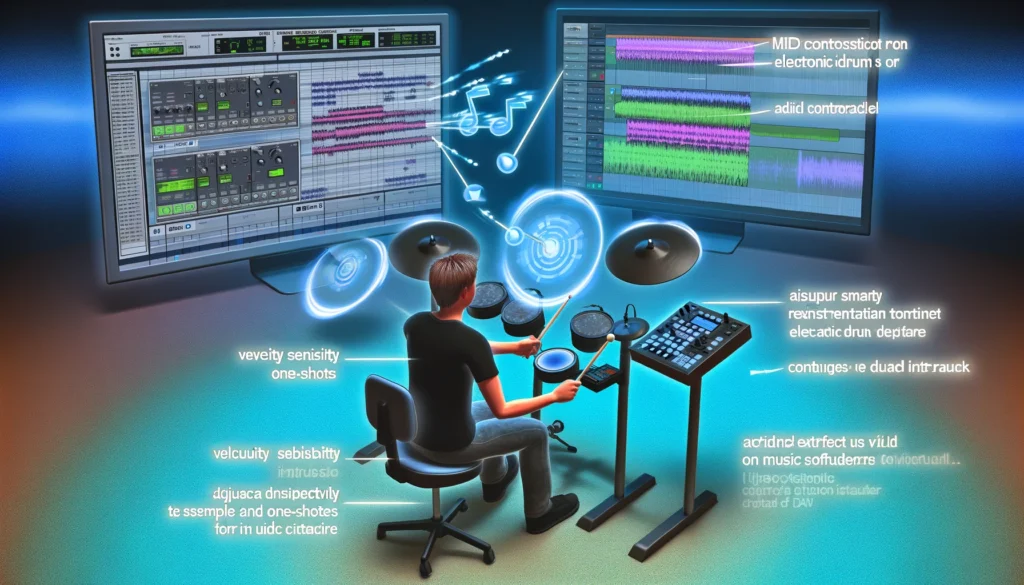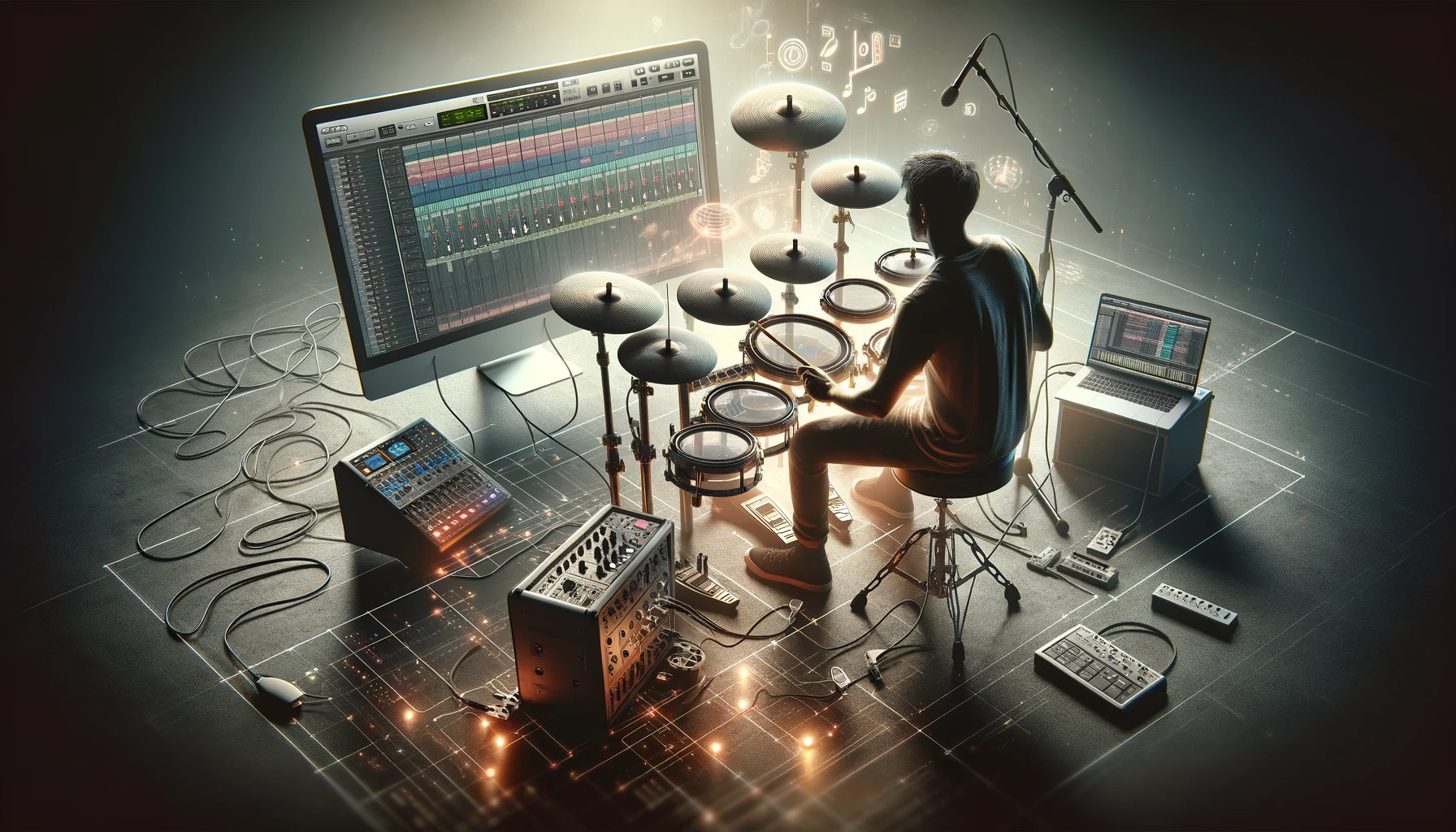Electronic drum kits offer drummers an affordable, intuitive way to control virtual instruments and MIDI software.
With some basic gear and configuration, the tactile playing technique from electronic drum pads and cymbals can shape limitless sounds in music production software and synth workstations.
In this quick guide, we’ll outline everything involved in connecting electronic drums for MIDI and leveraging your performance technique to manipulate software instruments.
Let’s dive in…
Use Electronic Drums for MIDI Backing Tracks

Electronic drum kits connected via MIDI open possibilities for drummers to play along with their favorite backing tracks.
Most DAWs and many standalone hardware workstations include built-in rhythm pattern generators and full backing band arrangements in genres like rock, pop, jazz, blues, country, and more.
By connecting electronic drums to playback devices via MIDI, drummers can access these high quality backing tracks and replace the canned drum part with their own live playing.
This allows practicing, jamming, writing, and even gigging or recording with pro-quality arrangement support.
We’ll explore integration concepts more below.
Why Use Electronic Drums as a MIDI Controller?

Electronic drums can serve as an extremely versatile MIDI controller for music production and live performance.
Compared to high-end MIDI keyboards and pad controllers, electronic drum kits provide a more affordable way to interface with digital audio workstations (DAWs), virtual instruments, and MIDI rigs.
The natural feel of playing electronic drums also allows for more expressive articulation and a wide dynamic range to control the parameters of MIDI elements.
For starters, electronic drums provide a realistic playing experience that resembles an acoustic kit, unlike many MIDI controllers.
The tactile experience of striking pads and cymbals with drumsticks offers more organic expression than pressing buttons or tapping pads with fingers.
This helps drummers translate their technique directly into MIDI data.
The rubber pads and cymbals also have a wide sensitivity range, capturing subtle dynamics the player applies.
Furthermore, the layout of an electronic kit aligns well with MIDI implementation and routing.
Each pad or trigger can send a specific MIDI note number, allowing them to be mapped methodically to samples or instruments.
For example, a kick drum pad could consistently trigger a bass drum sample.
This makes an electronic kit intuitive to use for controlling virtual instruments and software.
Lastly, electronic drum kits present an all-in-one control surface and sound source at an affordable price point compared to professional MIDI controllers.
They contain the triggers, module, and cabling needed to generate MIDI information based on playing.
This allows them to integrate with DAWs and synth workstations out of the box, without extensive MIDI programming or configuration.
What You Need

To use an electronic drum kit for MIDI control, you will need the drum kit itself, a MIDI interface to connect to your computer or synth, music software and instruments that can receive MIDI data, and the appropriate connecting cables.
To begin:
Electronic Drum Kit
Many modern electronic drum kits come equipped with onboard MIDI ports or USB connections to transmit MIDI directly to programs and devices.
These include mainstream kits like those from Roland or Yamaha, but also budget kits in the sub-$500 range.
The key specifications to look for are MIDI out or USB MIDI connectivity.
You’ll also want a kit with enough pads and triggers to accommodate the needs of your virtual instruments or samples.
For example, a basic 4-piece kit may not provide enough individual pads if you need to trigger a multi-sampled orchestral library.
Prioritize versatile kits that allow expansion as your needs grow.
MIDI Interface
Device with MIDI Input :
To get MIDI data from your electronic drums into a DAW environment on your computer, you will need some kind of MIDI interface.
Audio interfaces, drum modules, and even standalone MIDI interfaces can receive MIDI.
This might be a basic one-in/one-out interface, or a multi-port hub to accommodate several devices.
For electronic kits with 5-pin MIDI out connectors, you will simply run a 5-pin MIDI cable from the MIDI out of the drums to the MIDI in port on your interface.
USB-equipped electronic kits can usually connect directly to a computer’s USB port for MIDI transmission.
DAW or Synthesizer
Software to Receive MIDI Data:
You will, of course, also need some kind of music software or synth that can receive MIDI notes and controller data.
This might be a digital audio workstation like Ableton Live, Logic Pro, or Pro Tools with MIDI track capability and virtual instrument plugins.
Standalone software synthesizers also work well.
DAWs allow you to record the MIDI performances as tracks to sequence drums, basslines, keyboards, and more.
The MIDI data can then control internal or third-party VST synth plugins.
Verify your production software accepts external MIDI input from controllers before purchasing.
MIDI Cables
To Connect Components
If your electronic drum kit does not have built-in USB connectivity, you will need 5-pin MIDI cables to create a signal chain from the drums through your MIDI interface into the computer.
You’ll want MIDI cables that are long enough to comfortably accommodate your studio layout.
High-quality, shielded MIDI cables are recommended for reliable transmission of MIDI data.
Budget jars usually include short 5-pin cables that may work for basic connections.
For longer cable runs, invest in heavier-gauge shielded cables.
How to Connect the Drums for MIDI

One of the advantages of electronic drum kits is the user-friendly process of connecting them to external MIDI devices.
Compared to intricate wiring of microphones, speakers, and preamps for acoustic kits, getting set up with MIDI is simple.
But there are still some key steps in terms of connections and channel assignments.
Connect MIDI Out from Drums
The first physical connections to make involve cables from the electronic drum module to other devices.
Nearly all drum modules feature a pair of traditional 5-pin MIDI ports for input and output.
MIDI out will transmit signals, while MIDI in allows external control of the drum sound module.
With 5-pin MIDI ports, connect MIDI cables between the Out of the drum kit to the MIDI In jack of your audio interface, drum module, or standalone MIDI interface you are using as a conduit to your DAW.
Many kits also allow connection via USB; in which case you would run a printer/device USB cable from the drum module directly over to a USB port on your computer.
Once connected, most kits have a quick MIDI test function to confirm the physical connections are working properly and data is being transmitted.
Set Up MIDI Channel Matching
DAW and Drums Must Align
In addition to correct physical connections, your drum module and DAW will need matching MIDI channel settings to communicate properly.
Think of MIDI channels like cable TV channels – the transmitter and receiver have to be tuned to the same channel to pass data.
Most drum module and DAW combinations allow you to specify a MIDI channel for input and output separately.
You will want to set the drum module’s MIDI out channel to match the channel your DAW track is configured to receive on. Channels 1-16 are available.
Even if connected properly via MIDI cables, mismatched channels will result in no MIDI data appearing from the drums.
Refer to your equipment manuals to configure the channel assignments appropriately.
Proper channel matching is one of the most common MIDI connectivity issues when things aren’t working.
Spending a minute to validate settings can resolve problems.
Map Drum Pads to MIDI Notes
The final step in basic MIDI setup for electronic drums is mapping each pad to the MIDI note numbers you want triggered for that drum sound.
Mapping ties the physical trigger to a specific MIDI note that is transmitted whenever that pad is struck.
By default, many kits come pre-mapped to General MIDI standards: MIDI note #36 = bass drum, #38 = snare, #42 = closed hi-hat, #46= open hi-hat, and so on.
GM mapping ensures basic compatibility with DAWs and synth workstations out of the box.
But for finer control or customization, most modules also allow remapping pads to alternate note numbers.
Custom mapping lets you tweak the implementation for your particular virtual instruments or type of music.
Just take care to map logically and keep notes organized for troubleshooting.
Using the Electronic Drums to Control MIDI

Once you have the electronic drum kit connected as a MIDI controller via cables or USB, properly configured the MIDI input and output channels, and mapped the pads as desired, it becomes simple to use the drum performance to control sounds and instruments within music software.
A few of the prime applications include:
Adjust Velocity Sensitivity
For Volume Dynamics
One of the main advantages of electronic kits for MIDI control versus programming notes is you can leverage the performance technique and sensitivity of the pads to shape dynamics.
The velocity values generated from playing softly or aggressively directly translates to controlling volumes and articulations.
By adjusting the module’s velocity response curve or sensitivity parameters, you can fine tune how your playing technique influences the MIDI note dynamics captured and sent.
Tweak settings to match your natural playing dynamics for responsive expression.
You may even create custom response curves optimized for MIDI control rather than realistic drums.
Triggering Samples and One-Shots
At their most basic functionality, using MIDI-connected electronic drums allows you to trigger one-shot drum samples and sound effects.
Most DAWs feature drum sampler plugins like BFD or Addictive Drums that have banks of multisampled acoustic drums readily assignable to MIDI notes.
By mapping pads logically to MIDI notes triggering appropriate drum samples, you create a customizable drum interface.
Beyond acoustic kits, also consider using pads to trigger electronically generated or processed percussive sounds for experimental textures not possible from real drums.
This turns your kit into a unique hybrid instrument.
Controlling External Synthesizers
Rather than only triggering basic audio samples within a DAW, electronic drums open possibilities for manipulating external hardware synthesizers via MIDI as well.
Vintage drum machines and classic analog synths often lack the ability to store or sequence complex patterns but thrive at hands-on sound manipulation.
Connecting the MIDI out from electronic drums to vintage gear like classic Roland, Linn, or Oberheim instruments combines modern playability with coveted retro sound generation.
This turns static synths into real-time playable instruments via MIDI.
Using your kit to tweak filter or pitch settings in real time takes this a step further.
Conclusion
Using electronic drums as a MIDI controller opens up endless creative possibilities for music production and performance.
With the right drum kit, MIDI interface, cables, and music software, drummers can leverage their natural technique to manipulate virtual instruments, trigger unique hybrid sounds, and bring vintage gear into the modern creative workflow.
After setting up connections, channels, and MIDI mapping, electronic kits become intuitive instruments for dynamic MIDI control.
Whether seeking to expand a studio rig or augment a live performance, electronic drums provide an expressive, affordable, and seamless way to interface acoustic playing with the digital domain.
